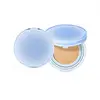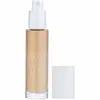What's inside
What's inside
 Key Ingredients
Key Ingredients

 Benefits
Benefits

 Concerns
Concerns

 Ingredients Side-by-side
Ingredients Side-by-side

Water
Skin ConditioningDibutyl Adipate
EmollientTitanium Dioxide
Cosmetic ColorantPropanediol
SolventEthylhexyl Salicylate
UV AbsorberHomosalate
Skin ConditioningEthylhexyl Triazone
UV AbsorberNiacinamide
SmoothingDiethylamino Hydroxybenzoyl Hexyl Benzoate
UV FilterButyloctyl Salicylate
Skin ConditioningCoco-Caprylate/Caprate
Emollient1,2-Hexanediol
Skin ConditioningCaprylic/Capric Triglyceride
MaskingPanthenol
Skin ConditioningPhenyl Trimethicone
Skin ConditioningAdansonia Digitata Fruit Extract
EmollientPrunus Persica Flower Extract
MoisturisingHydrogenated Lecithin
EmulsifyingSodium Hyaluronate
HumectantPentylene Glycol
Skin ConditioningPolyhydroxystearic Acid
EmulsifyingGlyceryl Stearate
EmollientIsononyl Isononanoate
EmollientButylene Glycol
HumectantHydroxypropyl Methylcellulose Stearoxy Ether
Triethoxycaprylylsilane
Polyacrylate Crosspolymer-6
Emulsion StabilisingAluminum Hydroxide
EmollientPEG-240/Hdi Copolymer Bis-Decyltetradeceth-20 Ether
StabilisingAmmonium Acryloyldimethyltaurate/Vp Copolymer
Ethylhexylglycerin
Skin ConditioningAlumina
AbrasiveStearic Acid
CleansingAdenosine
Skin ConditioningT-Butyl Alcohol
PerfumingPolyglyceryl-3 Polydimethylsiloxyethyl Dimethicone
Skin ConditioningSodium Acrylate/Sodium Acryloyldimethyl Taurate Copolymer
Emulsion StabilisingCeramide NP
Skin ConditioningPolyisobutene
Tocopherol
AntioxidantPEG-10 Rapeseed Sterol
CleansingPotassium Laurate
EmulsifyingDipropylene Glycol
HumectantSorbitan Oleate
EmulsifyingCaprylyl/Capryl Glucoside
CleansingGlycereth-20
HumectantDimethylsilanol Hyaluronate
HumectantHydrolyzed Sodium Hyaluronate
Skin ConditioningHydrolyzed Hyaluronic Acid
HumectantPotassium Hyaluronate
Skin ConditioningHyaluronic Acid
HumectantSodium Hyaluronate Crosspolymer
HumectantHydroxypropyltrimonium Hyaluronate
Sodium Hyaluronate Dimethylsilanol
HumectantSodium Acetylated Hyaluronate
HumectantParfum
MaskingCI 77492
Cosmetic ColorantCI 77491
Cosmetic ColorantCI 77499
Cosmetic ColorantWater, Dibutyl Adipate, Titanium Dioxide, Propanediol, Ethylhexyl Salicylate, Homosalate, Ethylhexyl Triazone, Niacinamide, Diethylamino Hydroxybenzoyl Hexyl Benzoate, Butyloctyl Salicylate, Coco-Caprylate/Caprate, 1,2-Hexanediol, Caprylic/Capric Triglyceride, Panthenol, Phenyl Trimethicone, Adansonia Digitata Fruit Extract, Prunus Persica Flower Extract, Hydrogenated Lecithin, Sodium Hyaluronate, Pentylene Glycol, Polyhydroxystearic Acid, Glyceryl Stearate, Isononyl Isononanoate, Butylene Glycol, Hydroxypropyl Methylcellulose Stearoxy Ether, Triethoxycaprylylsilane, Polyacrylate Crosspolymer-6, Aluminum Hydroxide, PEG-240/Hdi Copolymer Bis-Decyltetradeceth-20 Ether, Ammonium Acryloyldimethyltaurate/Vp Copolymer, Ethylhexylglycerin, Alumina, Stearic Acid, Adenosine, T-Butyl Alcohol, Polyglyceryl-3 Polydimethylsiloxyethyl Dimethicone, Sodium Acrylate/Sodium Acryloyldimethyl Taurate Copolymer, Ceramide NP, Polyisobutene, Tocopherol, PEG-10 Rapeseed Sterol, Potassium Laurate, Dipropylene Glycol, Sorbitan Oleate, Caprylyl/Capryl Glucoside, Glycereth-20, Dimethylsilanol Hyaluronate, Hydrolyzed Sodium Hyaluronate, Hydrolyzed Hyaluronic Acid, Potassium Hyaluronate, Hyaluronic Acid, Sodium Hyaluronate Crosspolymer, Hydroxypropyltrimonium Hyaluronate, Sodium Hyaluronate Dimethylsilanol, Sodium Acetylated Hyaluronate, Parfum, CI 77492, CI 77491, CI 77499
Water
Skin ConditioningCyclopentasiloxane
EmollientTalc
AbrasiveIsononyl Isononanoate
EmollientButylene Glycol
HumectantBehenyl Dimethicone
Skin ConditioningCetyl PEG/PPG-10/1 Dimethicone
EmulsifyingOctyldodecanol
EmollientDisteardimonium Hectorite
StabilisingPhenoxyethanol
PreservativeHydrogen Dimethicone
Sodium Dehydroacetate
PreservativeGlycerin
HumectantPentylene Glycol
Skin ConditioningAluminum Hydroxide
EmollientDisodium EDTA
Triethoxycaprylylsilane
Citric Acid
BufferingFructose
HumectantSodium Hydroxide
BufferingUrea
BufferingAllantoin
Skin ConditioningMaltose
MaskingMangifera Indica Seed Butter
Skin ConditioningSodium Chloride
MaskingSodium Lactate
BufferingSodium PCA
HumectantTrehalose
HumectantTropolone
Skin ConditioningPersea Gratissima Oil
Skin ConditioningPhytosterols
Skin ConditioningGlucose
HumectantSodium Hyaluronate
HumectantOlea Europaea Fruit Oil
MaskingSorbitan Oleate
EmulsifyingAscorbyl Palmitate
AntioxidantTocopheryl Acetate
AntioxidantWater, Cyclopentasiloxane, Talc, Isononyl Isononanoate, Butylene Glycol, Behenyl Dimethicone, Cetyl PEG/PPG-10/1 Dimethicone, Octyldodecanol, Disteardimonium Hectorite, Phenoxyethanol, Hydrogen Dimethicone, Sodium Dehydroacetate, Glycerin, Pentylene Glycol, Aluminum Hydroxide, Disodium EDTA, Triethoxycaprylylsilane, Citric Acid, Fructose, Sodium Hydroxide, Urea, Allantoin, Maltose, Mangifera Indica Seed Butter, Sodium Chloride, Sodium Lactate, Sodium PCA, Trehalose, Tropolone, Persea Gratissima Oil, Phytosterols, Glucose, Sodium Hyaluronate, Olea Europaea Fruit Oil, Sorbitan Oleate, Ascorbyl Palmitate, Tocopheryl Acetate
 Reviews
Reviews

Ingredients Explained
These ingredients are found in both products.
Ingredients higher up in an ingredient list are typically present in a larger amount.
Aluminum Hydroxide is a form of aluminum. It can be naturally found in nature as the mineral gibbsite. In cosmetics, Aluminum Hydroxide is used as a colorant, pH adjuster, and absorbent.
As a colorant, Aluminum Hydroxide may add opacity, or reduce the transparency. Aluminum hydroxide is contains both basic and acidic properties.
According to manufacturers, this ingredient is an emollient and humectant. This means it helps hydrate the skin.
In medicine, this ingredient is used to help relieve heartburn and help heal ulcers.
There is currently no credible scientific evidence linking aluminum hydroxide in cosmetics to increased cancer risk.
Major health organizations allow the use of aluminum hydroxide in personal care products and have not flagged it as a carcinogenic risk at typical usage levels.
Learn more about Aluminum HydroxideButylene Glycol (or BG) is used within cosmetic products for a few different reasons:
Overall, Butylene Glycol is a safe and well-rounded ingredient that works well with other ingredients.
Though this ingredient works well with most skin types, some people with sensitive skin may experience a reaction such as allergic rashes, closed comedones, or itchiness.
Learn more about Butylene GlycolIsononyl Isononanoate is a synthetic skin-conditioner and texture enhancer. It is created from nonanoic acid, a fatty acid found in cocoa and lavender oil.
As an emollient, Isononyl Isononanoate helps keep your skin soft and smooth. This is because emollients create a barrier on the skin to trap moisture in.
Isononyl Isononanoate helps give products a velvet feel and improves spreadability.
Learn more about Isononyl IsononanoatePentylene glycol is typically used within a product to thicken it. It also adds a smooth, soft, and moisturizing feel to the product. It is naturally found in plants such as sugar beets.
The hydrophilic trait of Pentylene Glycol makes it a humectant. As a humectant, Pentylene Glycol helps draw moisture from the air to your skin. This can help keep your skin hydrated.
This property also makes Pentylene Glycol a great texture enhancer. It can also help thicken or stabilize a product.
Pentylene Glycol also acts as a mild preservative and helps to keep a product microbe-free.
Some people may experience mild eye and skin irritation from Pentylene Glycol. We always recommend speaking with a professional about using this ingredient in your routine.
Pentylene Glycol has a low molecular weight and is part of the 1,2-glycol family.
Learn more about Pentylene GlycolSodium Hyaluronate is hyaluronic acid's salt form. It is commonly derived from the sodium salt of hyaluronic acid.
Like hyaluronic acid, it is great at holding water and acts as a humectant. This makes it a great skin hydrating ingredient.
Sodium Hyaluronate is naturally occurring in our bodies and is mostly found in eye fluid and joints.
These are some other common types of Hyaluronic Acid:
Learn more about Sodium HyaluronateSorbitan Oleate is created from compounds in oleic acid and sorbitol.
It is used to stabilize a product by preventing ingredients from separating. Emulsifiers help keep ingredients together, such as oils and water.
According to a manufacturer, the ingredient Sorbitan Monooleate shares an INCI name with this one.
Sorbitan Oleate may not be fungal acne safe. It can also worsen oily skin.
Learn more about Sorbitan OleateTriethoxycaprylylsilane is a silicone used to bind and stabilize ingredients.
As an emulsifier, it helps prevent ingredients from separating. This can help elongate the shelf life of products.
Triethoxycaprylylsilane is often used to coat mineral sunscreens ingredients to help give a better feel. It also helps reduce oxidative stress in sunscreens.
Learn more about TriethoxycaprylylsilaneWater. It's the most common cosmetic ingredient of all. You'll usually see it at the top of ingredient lists, meaning that it makes up the largest part of the product.
So why is it so popular? Water most often acts as a solvent - this means that it helps dissolve other ingredients into the formulation.
You'll also recognize water as that liquid we all need to stay alive. If you see this, drink a glass of water. Stay hydrated!
Learn more about Water